Key takeaways:
- Charity should focus on connection and understanding individual stories behind homelessness, rather than just providing material aid.
- Sharing personal experiences and leading by example can inspire others to engage in charitable activities.
- Building lasting relationships with donors requires storytelling and fostering trust through meaningful interactions and transparency.
- Community fundraising events and collaborative efforts significantly enhance the impact of charitable initiatives and strengthen community bonds.
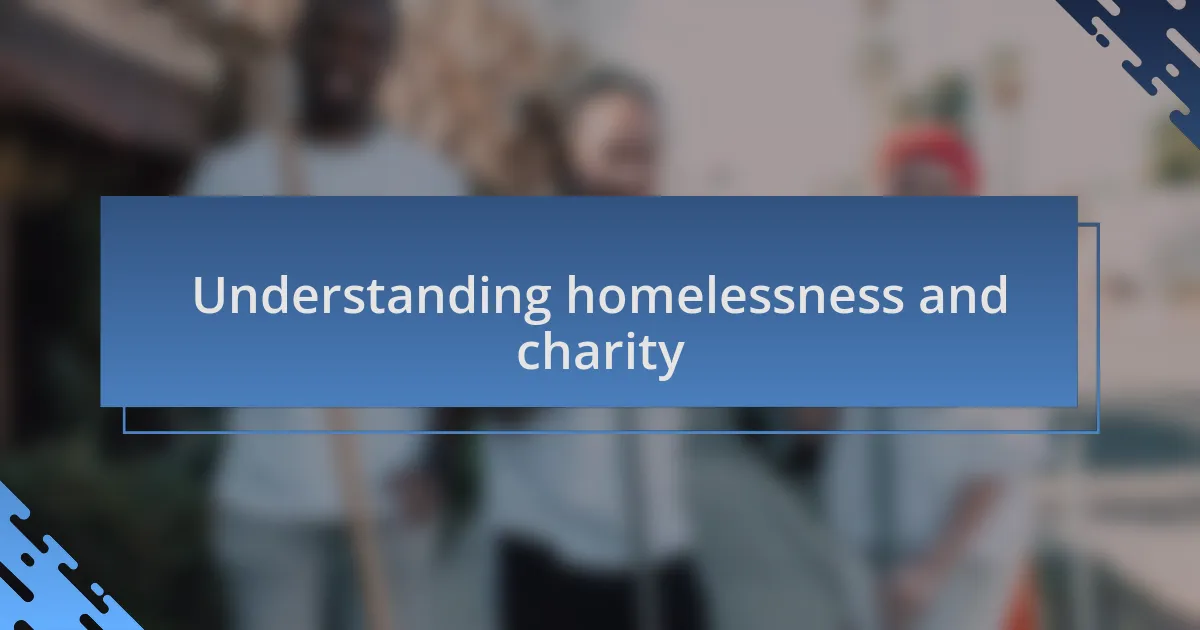
Understanding homelessness and charity
Understanding homelessness is crucial in shaping our approach to charity. Often, we see homelessness defined by statistics or news headlines, but behind every number is a story—a person with dreams, fears, and hopes. I’ve met individuals who have faced unimaginable struggles, and it dawned on me: when was the last time we truly listened to those stories instead of just donating?
Charity isn’t just about giving; it’s about connection. I remember volunteering at a local shelter and engaging in conversations with people seeking help. Their resilience inspired me deeply. These moments made me realize that charity is as much about compassion and understanding as it is about resources. How often do we consider what someone truly needs beyond material goods?
Moreover, I’ve learned that effective charity must address the underlying causes of homelessness. It’s not always about one-time donations; it’s about sustainable solutions that empower individuals. Have you ever thought about the systemic issues that lead someone to the streets? By understanding these complexities, we can create more meaningful impact through our charitable efforts.
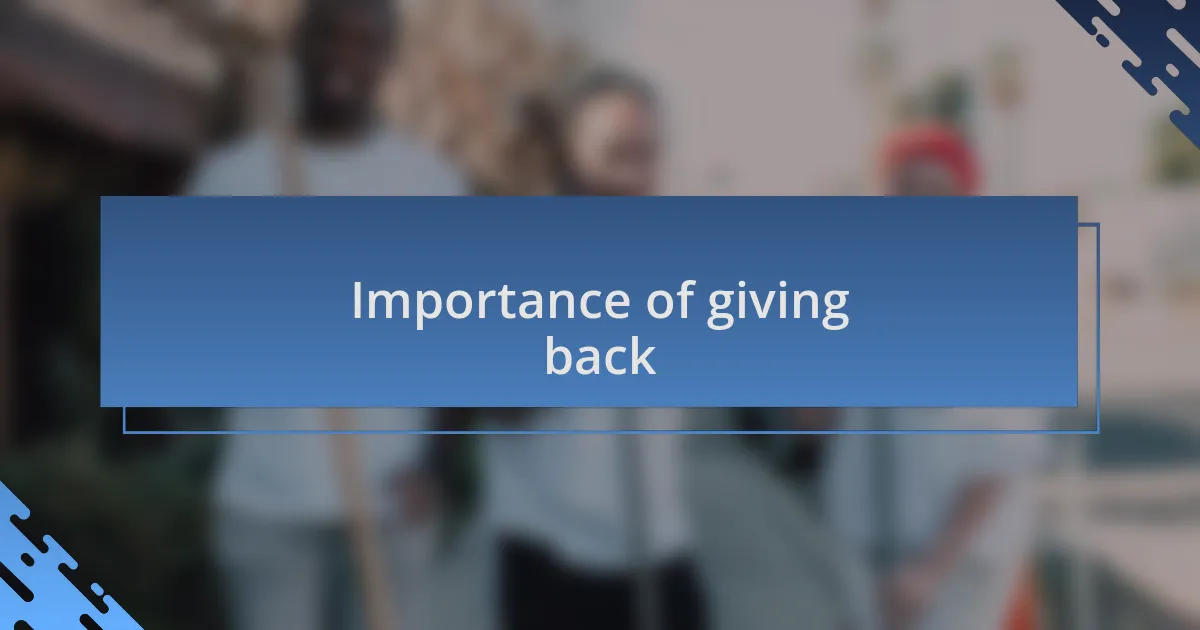
Importance of giving back
Giving back holds immense importance, not only for those who receive help but also for the givers themselves. I recall a day volunteering at a food bank when I witnessed the joy in someone’s eyes simply because they felt seen and valued. It struck me how powerful acts of generosity can be, transcending the mere exchange of goods and fostering a sense of community.
When we contribute to the well-being of others, we nurture our own humanity. I often find myself reflecting on moments spent with people facing homelessness—sharing stories, laughter, and sometimes tears. These experiences remind me that giving back can fill us with purpose and connection, illustrating that we’re all part of a larger human tapestry.
Additionally, I believe that giving back encourages others to follow suit. Have you noticed how kindness can be contagious? I’ve seen the ripple effect of one person’s generosity inspiring a whole group to take action. It emphasizes that each time we lend a hand, we are not just helping an individual but igniting a collective effort to uplift our community.
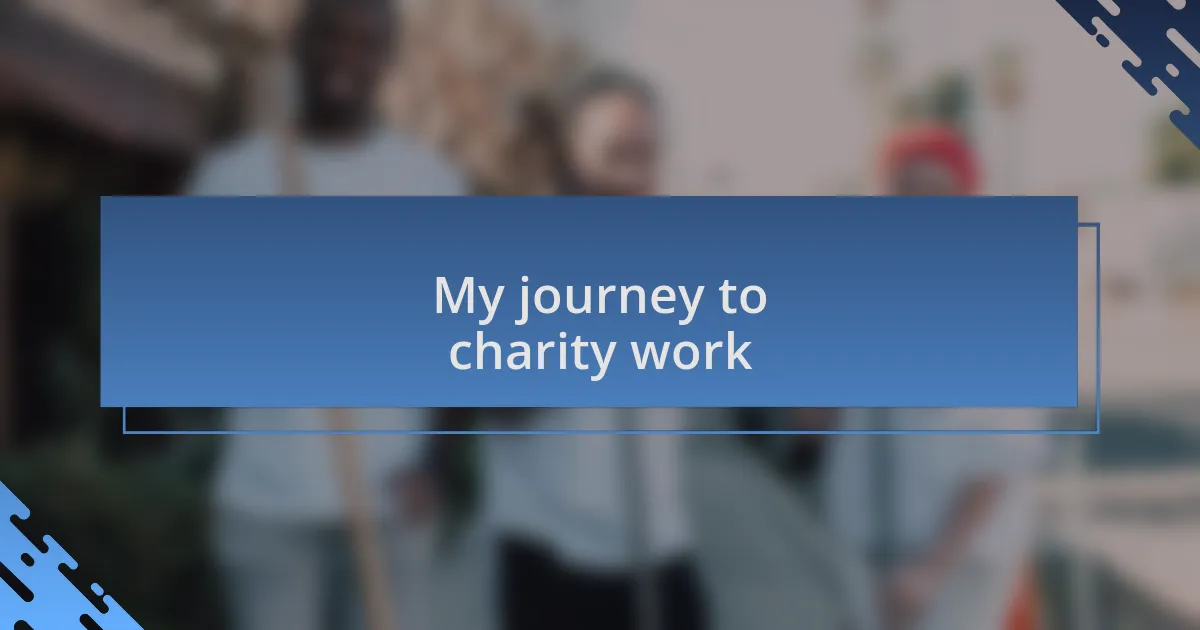
My journey to charity work
My journey into charity work began unexpectedly during a casual conversation with a neighbor who was passionate about helping the local homeless community. One evening, she invited me to join her at a tent city to distribute warm clothing. I remember the mix of hesitation and excitement I felt, unsure if I would make a difference. But as I watched people smile gratefully for something as simple as a jacket, I realized I was part of something much larger than myself.
Over time, I became more involved, seeking out ways to contribute regularly. One particularly impactful experience was when I organized a small fundraiser among my friends. Each of us donated what we could, and together we collected enough to provide meals for a local shelter for an entire week. That moment made me wonder: what if everyone I knew did just a little bit more in their own way? It sparked conversations that inspired even more friends to join in, illustrating how simple actions can lead to significant change.
Reflecting on my journey, I’ve learned that charity work isn’t just a series of tasks; it’s about building meaningful connections. I often think about my first experience—how the smiles of those I helped weren’t just reflections of gratitude; they were reminders of our shared humanity. Every time I return to the community, I see familiar faces and new ones, which deepens my commitment and fuels my passion to keep giving back. How can we not feel moved to act when there’s such a profound need around us?
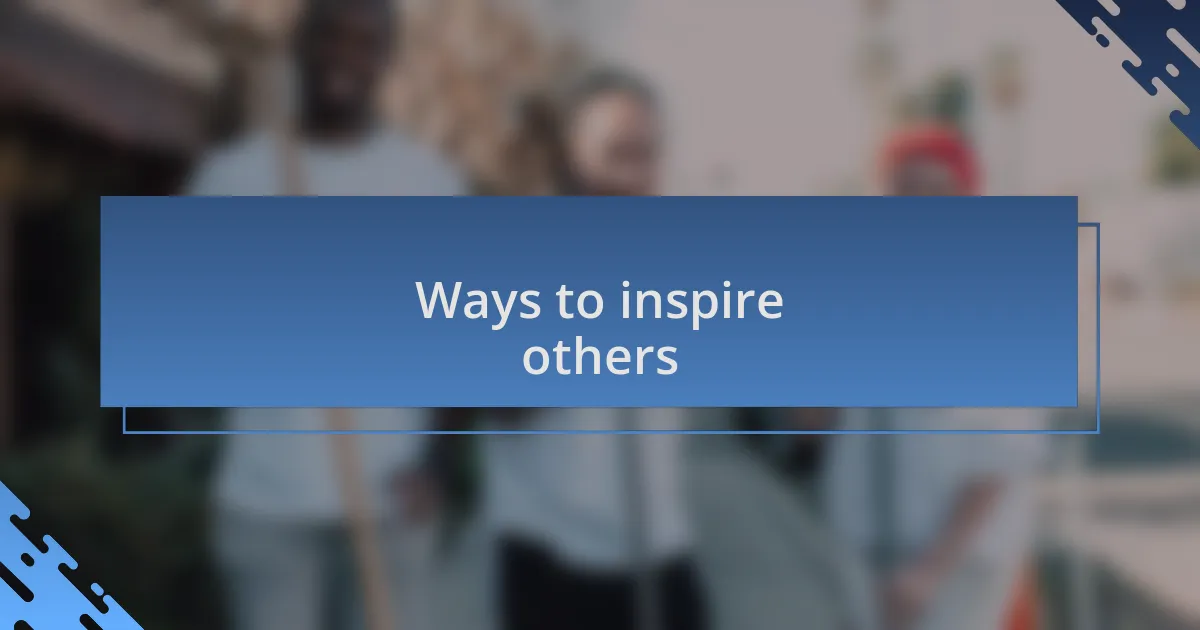
Ways to inspire others
One effective way to inspire others is to share personal stories that highlight the impact of giving back. I remember once sharing my experience of helping a single mother at a shelter who broke down in tears after receiving assistance. Her gratitude resonated with my friends, motivating them to think about how they could make a difference in someone else’s life. How can one story not spark a flame in the hearts of those who hear it?
Another approach is to lead by example. When I decided to spend my Saturday volunteering at a soup kitchen, I invited a few friends to join me without any pressure. As we worked side by side, I could see their initial reluctance fade into engagement and laughter. It was beautiful to witness how our collective effort brought not just nourishment to others but also camaraderie among ourselves. Have you ever felt the joy of being part of a cause alongside your friends?
Lastly, creating an opportunity for others to participate can be incredibly inspiring. I once hosted a community potluck where everyone brought a dish to share, and we collected donations for local charities instead of a ticket fee. That evening became a vibrant celebration of compassion. It was amazing to see how people left feeling uplifted, not just from the food, but from having contributed together. Isn’t it incredible how a simple gathering can transform into a catalyst for giving?
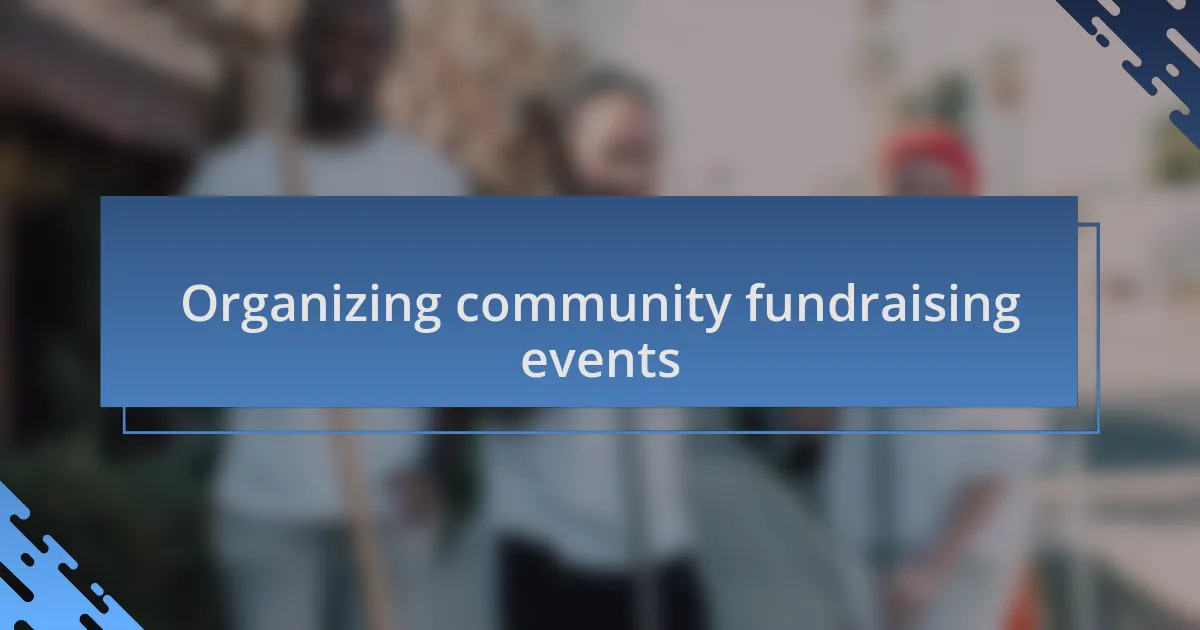
Organizing community fundraising events
Organizing community fundraising events is a powerful way to unite people toward a common goal. I remember when I coordinated a charity run in my neighborhood. The excitement was palpable as participants donned bright shirts and shared their commitment to raising funds for the homeless. Watching families, friends, and even local businesses come together was a heartwarming reminder of what is possible when we rally around a cause. Have you ever seen a community transform through shared effort?
One memorable moment came during the pre-race activities when a local band volunteered to perform. Their music not only set a joyful tone, but it also sparked conversations among strangers. As I walked through the crowd, I overheard people sharing stories of their own connections to homelessness. These heartfelt exchanges reinforced the idea that everybody has a role to play in this fight, enhancing our common understanding. Have you experienced the magic of music bringing people together for a greater purpose?
In another instance, I organized a silent auction featuring items donated by local artisans. It was touching to see how grateful they were to contribute, knowing their work could help those in need. Attendees were excited to bid on unique pieces, and the thrill of the auction created a spirit of generosity that permeated the room. That night, we not only raised funds but also fostered a deeper appreciation for community involvement. Isn’t it fascinating how a shared event can weave connections that extend beyond the night itself?

Personal stories of impact
There’s something deeply uplifting when you hear how a single act of kindness can ripple through a community. I once shared a meal with a group of homeless individuals, and their stories left a profound impact on me. One man spoke of a simple act – a warm sandwich given to him on a cold day – that had reignited his hope. Listening to him, I realized how small gestures often carry the most weight. Have you ever had a moment where you understood the true power of kindness?
At another event, we invited a guest speaker who had once faced homelessness himself. He captivated the audience with his journey, detailing how support from the community turned his life around. The room was filled with emotion as he spoke; it was evident that his story resonated with so many. I remember glancing around and noticing tears in people’s eyes while others exchanged understanding nods. Isn’t it incredible how sharing our vulnerabilities can inspire others to take action?
I’ve found that personal connections create a stronger drive to give back. During a volunteer day at a local shelter, I met a young woman who had started a nonprofit after overcoming her own struggles. Her passion was contagious, and by the end of the day, several volunteers expressed their desire to contribute in new ways. It was a reminder that inspiration can blossom from shared experiences, sparking hope and action in unexpected places. Have you felt that same spark igniting change in others?
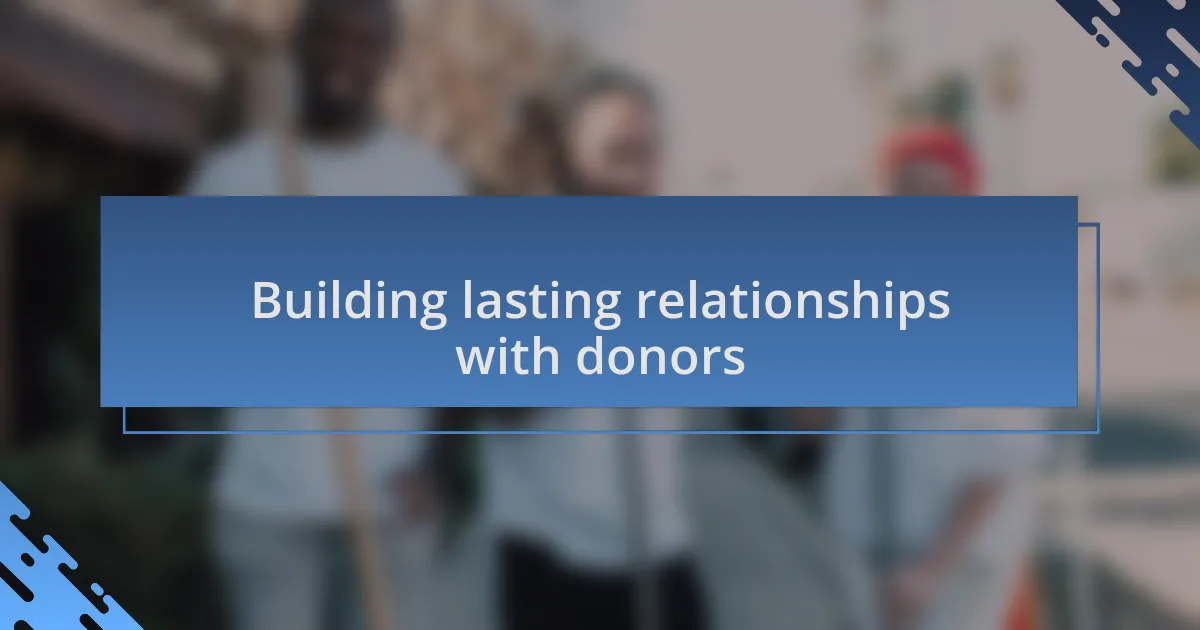
Building lasting relationships with donors
Building lasting relationships with donors requires more than just asking for support; it’s about creating meaningful interactions. I once wrote a heartfelt thank-you note to a donor who had given generously to our cause. In my message, I detailed how their contribution directly impacted the lives of individuals in our community. The donor expressed how much it meant to them to see the tangible results of their generosity. Have you ever wondered how a simple note could deepen someone’s commitment to your mission?
Every encounter with a donor is an opportunity to tell a story. When I met a potential supporter at a community event, I shared a story about a family we had helped. As I described their journey from hardship to stability, I could see the donor’s eyes light up. It dawned on me that personal narratives have an incredible power to forge connections. This experience reinforced my belief that the more authentic and engaging the dialogue, the more likely people are to remain engaged. Have you noticed how storytelling can change the way people see your mission?
Trust is the cornerstone of any lasting relationship with donors. Recently, I had the chance to invite a long-time supporter to watch our outreach program in action. Seeing firsthand the impact of their donations helped build that essential trust. After the event, we sat down for coffee, and they shared their thoughts on future contributions, feeling more invested than ever. How do you ensure that your donors feel secure in their support?